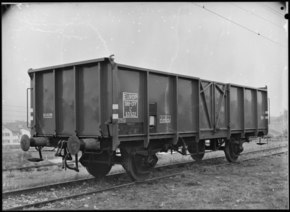RIV-EUROP


RIV-EUROP was the name of a European freight car pool that existed from 1953 to 2002. It allowed the free use of common types of freight wagons in the nine participating countries. RIV stands for Regolamento Internazionale Veicoli .
history
In the case of cross-border transports, it was common for a wagon from the sending country to be used and for it to return empty after unloading, unless there was a transport in the opposite direction that required the same type of wagon. This resulted in long turnaround times and a high proportion of empty trips. That is why the Deutsche Bundesbahn DB and the French state railway SNCF agreed that from May 1951 100,000 specially marked freight wagons could be reloaded immediately after unloading, as if it were a separate freight wagon. A German freight wagon could therefore be used for domestic transport in France or drive from France to a third country. He could then return from the third country to one of the countries participating in the pool. Initially 40,000 covered and 60,000 open freight wagons were placed in the pool and marked with the "EUROP" symbol.
The success of the EUROP Agreement also convinced other European countries and so the EUROP-Pool was extended to all of Western Europe (in the political sense of the time) on January 1, 1953, as long as the networks concerned were normal-gauge and directly connected to one another. When assigning the UIC ownership codes, the EUROP Agreement was taken into account by giving all the state railways involved a code starting with 8:
- 80 DB Germany
- 81 ÖBB Austria
- 82 CFL Luxembourg
- 83 FS Italy
- 84 NS Netherlands
- 85 SBB-CFF-FFS Switzerland
- 86 DSB Denmark
- 87 SNCF France
- 88 SNCB-NMBS Belgium
In order to be able to handle more transports with trolleys in the pool and to meet the changing needs of the shipping industry, additional types of trolleys have been added to the pool. The following wagon types in 11 categories were in the EUROP pool:
- open wagons (E, Es) and those with bogies (Eaos)
- covered wagons (Gs, Gbs, formerly also Gms)
- Schiebewandwagen (Hbis, Hbbillns)
- Bulk wagon (Fcs)
- Flat wagons (Ks) and those with bogies (Rs, Res)
With the liberalization of the railway sector, new transport companies came into play and the needs also changed. Container wagons , cement silo wagons , wagons with an opening roof , wagons for transporting sheet metal coils and many other types of wagons were not available in the EUROP-Pool. The importance of these types of car increased more and more. In container traffic, liner transports were established, with the same wagons always going back and forth between the same destinations. These developments led to the EUROP car pool being dissolved at the end of 2002. Another argument put forward was that maintenance was more difficult to guarantee because the wagons were scattered all over Europe.
swell
- E. Frohne, chairman of the board of directors of the Deutsche Bundesbahn: Europe's freight car pool is being expanded , in: Die Zeit No. 56/1952, September 4, 1952 [1]
- News in brief , Eisenbahn-Amateur magazine 10/2002
- Horst J. Obermayer: Paperback German freight cars. 1st edition, Frankh'sche Verlagshandlung, Stuttgart 1980, ISBN 3-440-04855-1
